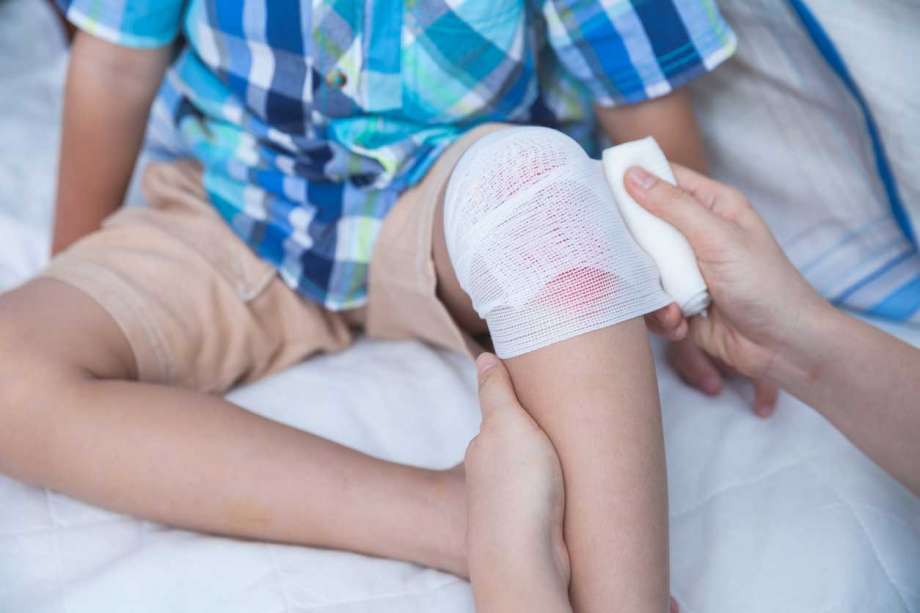First Aid for Scrapes, Cuts, Bumps, and Bruises

The Difference Between a Cut, a Bump, and a Bruise
A cut and a bruise, with or without swelling, are basically the same thing, except that one occurs at the body's surface, and the other occurs under the surface, in the soft tissue below the skin.
Bumps and bruises are damage that occurs in the soft tissue under the skin. In fact, the ugly black and blue marks you see when you bruise are really blood clots that form under the skin. The worse they look, the more they are clotting and healing.
More: First Aid for Children
Under the following conditions, there is no need to call for medical assistance when a person suffers a cut, scrape, bump, or bruise:
- The injury is small (less than 1/2 inch around).
- There is no bleeding, or only slight bleeding. Make sure you follow the universal guidelines, such as wearing protective gloves, to prevent the spread of HIV or any other dangerous infections. (See How to Treat Wounds and Stop Bleeding
for first aid care for bleeding.)
- The victim is not in excessive pain.
- The victim does not feel numbness or tingling.
- The person is not suffering any paralysis.
- The victim does not seem to have any broken bones or dislocation at the joints. (If the victim is in a great amount of pain and the shoulder, leg, arm, or ankle appears to be lying or hanging at an awkward ankle, there is a good chance he or she has a broken bone or a dislocation.)
First Aid for Cuts and Scrapes

Here are simple first aid procedures for treating minor scrapes and cuts:
- If the injured area has a skin scrape, wash it with mild soap and lukewarm water.
- Apply Bacitracin or some other type of antibacterial cream or spray to prevent infection.
- Cover the wound with a sterile gauze pad and tape or a simple Band-Aid.
First Aid for Bruises

Bruises on the hands, fingers, feet, and toes can cause more problems than those that occur on knees, shins, or arms. Your hands and feet are a complicated network of motor functions, nerve endings, and flexibility. Any problems in these areas can cause a disability. For example, stubbing a toe might make walking difficult, or a damaged finger might keep you away from the computer. If you or someone around you experiences more than minor swelling or bruising after bumping into something or falling down, call your physician.
More: First Aid for Burns
Since bruises (and their potential partner, swelling) don't break through the skin, there is a difference in first aid treatment. Follow these steps for treating different types of bruises:
First Aid for Blisters
A blister is a built-up, fluid-filled irritation under the surface of the skin. A blood blister is a red blister that contains blood. A fever blister is another name for a cold sore or a herpes simplex at the lips. None of these are dangerous, but if they are accompanied by excessive pain or fever or if they grow larger, you should see your physician for proper drainage and possible medication.
- Immediately apply an ice pack to the bruise to reduce swelling. (If an ice pack isn't available, use ice wrapped in a cloth or as cold a compress as you can make.)
- If possible, elevate the bruised area so that it is higher than the heart. This keeps blood from “pooling” in the affected area (and thus creating more internal bleeding and swelling).
- Keep the bruise elevated for approximately 15 minutes if the wound is minor. If the bruise is severe and it covers a large portion of the body, call for help. (See Bandaging Wounds for immobilizing techniques. Keep a severe bruise elevated for at least an hour or until a trained emergency care team arrives.
- If the bruise doesn't appear to be getting any better and more than 24 hours have passed, see your physician.
- Seek prompt medical help if there is any swelling around the bruise, especially if it occurs at a joint. This can signal danger to nerves, muscles, and bones, all of which require a trained physician's attention.
For more tips on kids' health and safety:
First Aid for Hemorrhaging and Internal Bleeding
Hemorrhaging is another word for uncontrollable bleeding. Because it is caused by breakage in blood vessel walls, it is usually internal, which means you can't always tell that a person is (literally) bleeding to death!
Unfortunately, first aid procedures will not stop internal bleeding. The best thing to do is to call for help immediately. Then proceed with the first aid steps for shock (see Performing Mouth-to-Mouth Resuscitation).
The Warning Signs of Internal Bleeding
A slight amount of bleeding that creates a bruise under the skin is one thing, but hemorrhaging is quite another. Internal bleeding can be serious and can affect one's vital organs. The symptoms of internal bleeding are similar to those of shock:
- Pale, clammy skin
- Chills
- Cold hands and feet
- Dilated pupils
- Rapid, weak pulse
- Major swelling at the injury site
- Major or immediate black and blue marks at the wound